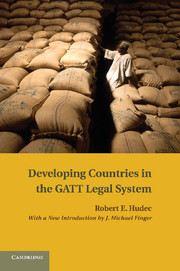PART I - A HISTORY OF THE LEGAL RELATIONSHIP
Published online by Cambridge University Press: 03 May 2011
Summary
INTRODUCTION
ON 30 OCTOBER 1947, governments of twenty-three countries signed the Final Act of the General Agreement on Tariffs and Trade (GATT). The General Agreement created a legal framework for a mutual reduction in tariffs negotiated between the signatory governments. It contained, first, each government's commitment to reduce tariffs (called its Schedule of Concessions) and, second, a code of behavior regulating other forms of government interference with international trade.
The GATT code of behavior rested on three central principles. The first was that while governments would not be prohibited from protecting domestic industries against foreign competition, all such protection should be in the form of tariffs. Under this first principle, governments accepted the obligation to eliminate the many other kinds of non-tariff measures affecting trade that had become common in the pre-war years – above all, restrictions limiting the quantity of imports allowed. The second principle was that while there would be no a priori limits on tariff levels, governments would participate in periodic negotiations aimed at gradually reducing existing levels. The third was the most-favored-nation (MFN) principle, requiring governments to treat the trade of all other GATT countries equally. Under the MFN principle, any advantage given to one GATT country had to be given immediately, and unconditionally, to every other GATT country.
- Type
- Chapter
- Information
- Developing Countries in the GATT Legal System , pp. 23 - 25Publisher: Cambridge University PressPrint publication year: 2010

